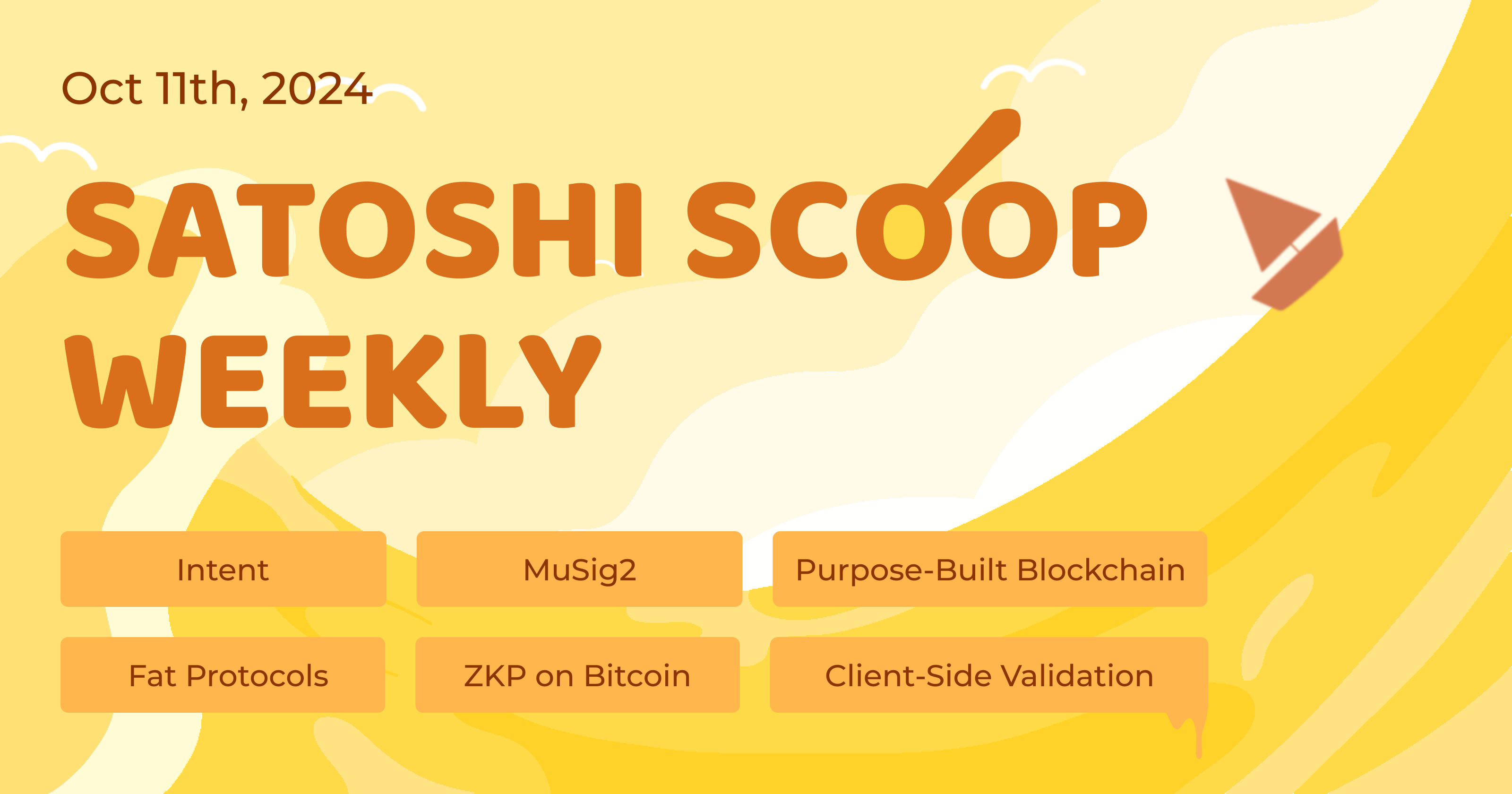Satoshi Scoop Weekly, 11 Oct 2024
 Cryptape
Cryptape
Crypto Insights
Why Fat Protocols Theory No Longer Works in Today's Crypto Landscape
Co-founder of JokeRace, David Phelps, believes that the current crypto ecosystem has involved since the introduction of the 'Fat Protocols' theory in 2016 (see Fat Protocols, by Joel Monegro). Interoperability between chains has increased, and crypto applications have built moats around users rather than liquidity. The 'Fat App Theory' will dominate the future development trend.
Asia Leads Bitcoin’s 2nd Season: A View from a Western Observer
Bitcoin culture did not leave China after the 2021 mining ban—at least not for long. Today, Asia, particularly China, is at the forefront of Bitcoin’s second season.
The Westerners will clutch their pearls about mechanism design and low-time preference mindset while Asian companies ship product after product into a hungry, frothy market. This trend shows no signs of slowing down.
China wants the revenue, the West can keep it’s influencers
Debate on the Decentralized Alternative Template for Universal Mining (DATUM)
Aaron van Wirdum argues that the Decentralized Alternative Templates for Universal Mining (DATUM) could effectively address Bitcoin mining centralization. With DATUM, miners (also known as "hashers") can choose the transactions they include in the blocks they find, while still sharing block rewards with other miners in the pool. This allows them to benefit from pooled mining without outsourcing transaction selection to pool operators, making regulation more difficult.
However, Paul Sztorc (author of BIP 300/301) disagrees, arguing that the concept of "centralized mining" is questionable. He states that the "number of pools" is a misleading concept, as a single pool can pretend to be multiple pools.
Additionally, pools can switch DATUM and Sv2 on or off anytime, making DATUM ineffective.
MuSig2 for Aggregating Schnorr Signatures Merged Into libsecp256k1
MuSig is a protocol for aggregating public keys and signatures for the Schnorr digital signature algorithm. It allows multiple users, each with their own private key, to create a combined public key that is indistinguishable from any other Schnorr pubkey, maintaining the same size as a single-user pubkey.
This merge marks a significant advancement in the practical deployment of MuSig2, as existing projects using libsecp256k1 will soon be able to use it in the next version.
Why Nervos is the Only Programmable Solution Most Closely Designed to Bitcoin: From a Crypto Store of Value Perspective
I believe that crypto infrastructure should be designed with a focus on store of value to be a sustainable long-term solution. Technological development without a store of value economy cannot create sustainable store of value infrastructure like Bitcoin, as it may lead to censorship, centralization, and community fragmentation.
Newly Launched Nostr Applications: Note-Taking, Real-Time Video Calls, SMS Notes, Audio Spaces
Comet Notes is a note-taking tool available on Linux and macOS.
HiveTalk is a real-time video calling application available on Nostr and Lightning browsers. GitHub repo.
NostrSMS enables sending Nostr notes via SMS. Source code.
Corny Chat is an open-source chat space based on Jam, integrating Nostr and Lightning, supporting file uploads, recurring events, and more.
Pollerama is a survey client that allows creating anonymous polls and collecting feedback, using contact lists and PoW requirements to reduce spam.
Top Reads on Blockchain and Beyond
When the Principle of Labor Division Extends to Web3: Is the Era of Purpose-Built Blockchains Coming?
Throughout the history of technological and social progress, the principle of labor division has been a core driving force. This concept transcended the Industrial Revolution and permeated today’s IT sector, where numerous microservices collaborate to form a unified service ecosystem.
What would happen if this paradigm were applied to the blockchain and Web3 domains? This article examines the past and present methodologies of blockchain infrastructure and discusses the future direction. It also explores what form of blockchain best suits this division-of-labor structures, aiming to gain a deeper understanding of the development trajectory and future outlook.
The Ultimate Guide to RGB, RGB++, and Client-Side Validation
The popularity of Ordinals, Inscriptions, and BRC-20 tokens shows strong demand for tokenized assets on Bitcoin. But while Ethereum’s smart contracts have thrived, Bitcoin’s commitment to simplicity and minimal on-chain logic has made asset issuance difficult. Inscriptions attempt to solve this by using Taproot scripts to store arbitrary data, but their heavy on-chain footprint could harm Bitcoin’s scalability and decentralization. Sidechains offer another option, but come with security and centralization risks, making neither solution ideal for Bitcoin asset tokenization.
Fortunately, renewed interest has returned to RGB. Inspired by Bitcoin’s colored coins, RGB leverages the Lightning Network to enable scalable tokenization without burdening Bitcoin’s base layer, maintaining its security and decentralization.
RGB++ draws inspiration from RGB and utilizes Bitcoin commitments and single-use seals to scale Bitcoin in both throughput and programmability by isomorphically binding UTXOs with cells on CKB. This approach mitigates all of RGB’s drawbacks while retaining most of the benefits, birthing a protocol that provides a significantly better developer and user experience.
Intent: Simplifying User Experience and Establishing a New Value Capture Model
Intent represents the outcome expected by users. An intent-centric system allows users to specify their transaction or operational goals through declarations, without needing to define the exact execution steps. Users can delegate the execution of their intent to the system, smart contracts, or third-party service providers.
This article suggests that intent assets represent the next phase of Web3, not only simplifying the user experience but also creating an entirely new value capture model. It uses dappOS as an example to illustrate the technical architecture and transaction mechanism based on intent.
Bitcoin PIPEs: Covenants and ZKPs on Bitcoin Without Soft Fork
Verification of succinct zero-knowledge proofs (ZKPs) on Bitcoin L1 has been deemed infeasible due to limitations in the Bitcoin Script language, such as the lack of covenants like CAT, CTV, and CSFS, as well as a small script size limit. These constraints prevent the implementation of Merkle tree path verification needed for commitment schemes like FRI/LPC and arithmetic operations requiring OP_MUL. Although proposals like BIP-347 have been suggested to introduce new opcodes, none have been adopted, leaving ZKP verification on Bitcoin L1 unresolved.
This paper proposes using Bitcoin PIPEs for ZKP verification by enabling Polynomial Inner Product Encryption (PIPE)-based SNARK verification on Bitcoin. The approach includes (i) emulating missing covenants (e.g., CAT) using Bitcoin PIPEs, and (ii) introducing a PIPE-based covenant opcode for Placeholder proof system verification. By generating unique keys and signatures based on proof conditions, this method overcomes Bitcoin Script limitations and opens new possibilities for applications on Bitcoin L1, including true Bitcoin zkRollups.
Subscribe to my newsletter
Read articles from Cryptape directly inside your inbox. Subscribe to the newsletter, and don't miss out.
Written by
